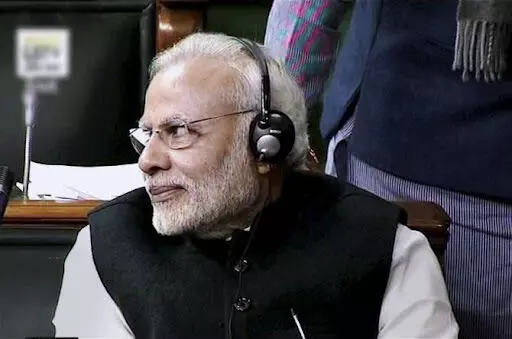TRENDING TAGS :
Why Ministers and MPs Wear Headphones in Parliament: A Constitutional Secret
Discover why Indian MPs wear headphones in Parliament. Learn about India's linguistic diversity, real-time translation system, interpreters' role, and the constitutional provisions ensuring every voice is heard.
Imagine a Member of Parliament from a remote village of multilingual India addressing Parliament in their native language, conveying the pain and aspirations of their region. Their words carry the fragrance of the soil they come from. But many MPs, ministers, and officials in Parliament might not understand their language. Without a system to bridge this communication gap, their voice could easily be lost.
However, that does not happen — because an invisible yet immensely powerful system of interpreters and headphones silently ensures smooth communication. The small headphones seen in Parliament are, in fact, one of the most beautiful symbols of India’s unity in diversity. Let’s understand why ministers and MPs wear headphones, the historical and constitutional significance behind it, and how the tireless work of interpreters keeps the wheels of democracy moving seamlessly.
Indian Constitution and Linguistic Diversity
India is a multilingual nation. Articles 343 to 351 of the Constitution deal with provisions related to language. According to the Constitution, Hindi is the official language of India, with English also recognized as an associate official language.
Recognizing India’s vast diversity, the Eighth Schedule of the Constitution grants official status to 22 languages — including Bengali, Tamil, Telugu, Malayalam, Urdu, Odia, Punjabi, Marathi, and more.
Now, imagine MPs from different states speaking in their mother tongues — how would others understand? That’s where the magical role of interpreters and headphones comes in.
How the Translation System Works in Parliament
Whether it’s the Lok Sabha or the Rajya Sabha, Parliament operates a simultaneous interpretation system. When an MP speaks in their native language, interpreters seated in booths instantly translate the speech into Hindi and English in real-time.
MPs and ministers listen to these translations live through their headphones.
Why Do MPs Wear Headphones?
-
To understand speeches in languages they do not know.
-
To prevent misunderstandings or communication gaps.
-
To ensure that parliamentary proceedings continue smoothly despite linguistic diversity.
History of Headphones and Real-Time Translation in Indian Parliament
The system of headphones and real-time interpretation in the Indian Parliament dates back to the early 1950s, when the Constitution came into effect, and regular parliamentary sessions began.
After January 26, 1950, proceedings in both Houses were conducted in Hindi and English. However, being a multilingual country, many MPs wished to speak in their mother tongues.
To address this challenge, Parliament established a comprehensive interpretation service in the 1950s. Headphones and channel-based live translation systems were installed so that members could hear translations instantly.
Initially, this service was available for major languages like Hindi, English, Tamil, and Bengali. Gradually, it expanded to cover all major Indian languages.
The Interpretation Wing of the Lok Sabha was formally established in 1956. Similarly, the Rajya Sabha set up its own independent interpretation service around the same time.
Technology Evolved Too
-
Early systems used simple wired headphones.
-
Later, digital multi-channel systems allowed MPs to choose Hindi or English translation by pressing a button.
-
In the 21st century, Parliament upgraded to wireless and high-quality sound systems.
The Crucial Role of Interpreters
Parliamentary interpreters are not ordinary translators. They undergo special training and possess:
-
Proficiency in at least two or three Indian languages,
-
Deep understanding of politics, law, and the Constitution,
-
Ability to listen and translate at high speed, as parliamentary debates move very fast,
-
Expertise in instantly grasping and translating complex words, idioms, and regional linguistic nuances.
Special interpretation branches operate under the Lok Sabha Secretariat and the Rajya Sabha Secretariat.
Languages and Translation in Parliament
-
Hindi and English are compulsory for Parliament’s proceedings.
-
However, members have the right to speak in any of the 22 scheduled languages.
-
Parliament currently offers translation services for all 22 languages.
Examples:
-
If a member speaks in Tamil, interpreters immediately translate it into Hindi and English.
-
Similarly, speeches in Marathi, Gujarati, Odia, Kannada, etc., are translated instantly.
Constitutional Provisions
Articles 120 and 210 of the Constitution govern the use of languages in Parliament and state legislatures.
-
Proceedings are primarily conducted in Hindi or English.
-
Members may address the House in any scheduled language.
-
In such cases, translation arrangements must be made to ensure everyone understands.
Thus, Parliament has made headphone-based simultaneous interpretation a mandatory feature.
A Thousand Voices Through One Headphone
That small headphone actually represents the diverse voices of a billion Indians. Every time an MP speaks in their native language, they bring the voice of their land, culture, and struggles into the heart of Delhi.
By wearing headphones, other MPs respectfully listen, understand, and engage. It is a living example of how India has transformed its linguistic diversity into a democratic strength.
Some Fascinating Facts
-
Over 150 language specialists work for parliamentary interpretation services.
-
Before each session, interpreters undergo special practice sessions.
-
In rare languages like Santhali or Manipuri, two-layer interpretation is done — first into Hindi, then into English.
-
Live broadcasts on Rajya Sabha TV and Lok Sabha TV also feature real-time interpretation.
Technical Setup
Each seat in Parliament has a small unit with a microphone and a headphone slot. Members can plug in headphones and choose between Hindi and English translations as needed. High-quality sound systems and devices are used to ensure no word is missed.
The Future: A New Revolution Through Technology
Parliament is now exploring Artificial Intelligence-based translation technologies. In the coming years, machine translation and automated voice interpretation could make proceedings even smoother.
However, human interpreters remain irreplaceable — because no machine can fully capture emotions and cultural contexts.
Conclusion
Next time you watch Parliament sessions on TV and see leaders wearing headphones, remember — it’s not just a technological aid. It is the dialogue of 1.4 billion souls, a chorus of countless languages like Hindi, Tamil, Urdu, Gujarati, Kannada, Assamese, and many more.
Wearing those headphones, MPs do not just hear each other’s words — they listen to each other’s feelings, struggles, and dreams.
It is one of the most beautiful images of Indian democracy, where the echoes of every dialect resonate through the halls of Parliament.


